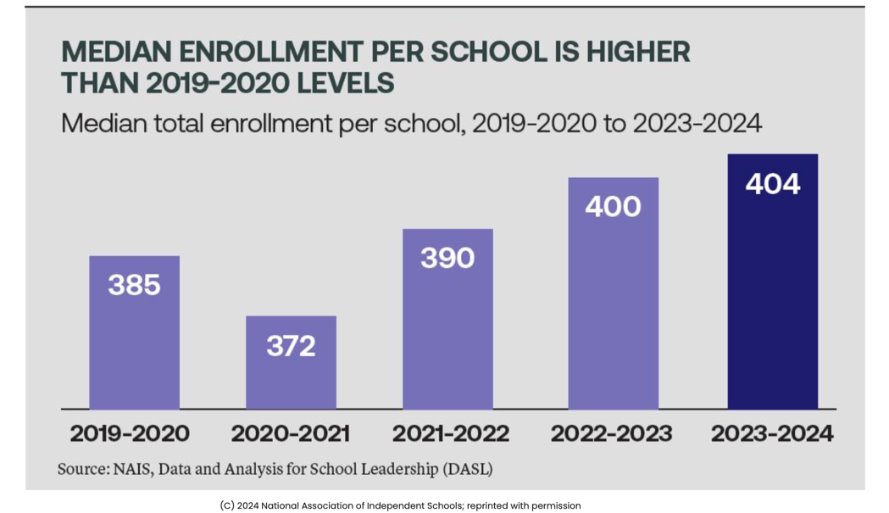While administrators and staff enjoy a much-deserved summer break, the private school admissions process will restart before you know it. To help teams create truly resonant experiences, the Ravenna® team conducted a deep-dive analysis of national trends affecting independent schools in their webinar, Inside Admissions: A Conversation on Data-Driven Enrollment Trends.
Panelists included the following team of in-house experts:
- Craig Dodson, VP of Customer Support
- Rachael Cramond, Director of Customer Experience
- Ben Sullivan, Ravenna Product Owner
The team was joined by Carmen Johnson of North Broward Preparatory School, an Enrollment Director with 22 years of enrollment management experience.
For those who missed this insightful discussion, we recap the presentation below. You can also watch the entire webinar below.
RELATED: Webinar: Inside Admissions: A Conversation on Data-Driven Enrollment Trends
State of Enrollment and National Overview: The Changing Landscape in Private K-12 Education
To begin, panelists touched on the national trends shaping private education. Pulling information from Ravenna’s extensive customer base, the National Association of Independent Schools (NAIS), and sources covering demographic, financial, and legislative opportunities and challenges, the team explained deeper meaning beneath the data.
School Enrollment Trends

As states increasingly encourage education diversity, private schools have benefited from stronger applicant pools that fuel expansion. Despite a pandemic-era dip in enrollment levels, the most recent year, 2023-24, shows a 7.5-percent increase in median student enrollment from 2019-20.

While overall enrollment trends up, a closer look at the numbers shows cause for concern. A direct correlation exists between school size and growth over this period, with larger schools experiencing more growth the larger the school size, while smaller schools were much more likely to see enrollment figures decline.
Private schools with the resources to recruit and enroll stand to further their impact the more they invest in expansion, while smaller schools can adopt smart tactics to ensure strong class sizes.
Demographic Trends
There are currently a record 4.7 million students enrolled in U.S. private schools. Of these, international students comprise 15 percent, showing the expanding impact of schools as recruitment efforts become more sophisticated.
National migration trends include an ongoing flight from urban to rural settings, driving enrollment shifts and regional growth for some schools, while increasing competition for students in many cities.
Likewise, declining birth rates in many urban areas nationwide are shrinking the pools of available K–12 students. To stay in front of these declines, urban private schools rely on more innovative recruitment strategies.
Financial Trends
Key economic concerns are also impacting schools as they plan for the 2025-26 academic year. Rising operational costs in the forms of inflation, cost-of-living salary raises, and capital expenses accompanying expansion plans may require tuition hikes, which risk pricing out some middle-income families, ultimately leading to a narrower applicant pool.
For others, it’s the opposite experience—demand is outpacing many schools’ ability to keep up. Applications continually increase from upper-income families, strengthening both applicant pools and financial security. In response, families’ desire for a transparent, standardized financial aid methodology remains high.
Families increasingly view private schools as an investment, and as a result, expect frequent updates via email, SMS, online portals, and apps.
Legislative Trends
Many states recently passed legislation providing public funding to private school students or plan to do so in the near future. Currently, over one million students use a combination of education savings accounts (ESAs), tax credits, and vouchers to pay for private K-12 education—for thousands of these families, independent schooling is otherwise unaffordable.
Johnson explained how these opportunities affect her state. “In Florida, there are state-funded scholarships available to students attending private schools,” she explained. “The tax dollars allocated per student when they attend public schools follows them to the private schools they attend.”
At the national level, the U.S. House of Representatives recently passed $5 billion in funding for private school scholarships. Keep an eye on this bill, as it promises to greatly expand the nationwide applicant pool and change private school admissions processes forever.
Key Insights from Ravenna Customer Data
Weaving together further insight, the panel turned to Ravenna customer data. Across all customers, schools nationwide saw a seven-percent drop in applications, and a six-percent drop in completed applications.
Broken down by grade level, lower and middle schools saw a steady year-over-year increase continue, while upper school applications have declined since the 2022-23 academic year.
This trend suggests an overall shift in students entering private schools at an earlier age, that families see private education as an investment covering the greater part of childhood, rather than a few years’ experience. Seventh grade (26 percent) and fourth grade (18 percent) experienced the largest year-over-year application increases.
“The pandemic really exposed the gaps between public and private lower school education,” Johnson explained. “Families are looking to start that investment earlier to give their children the best education possible.”
The average Ravenna customer has a 63 percent acceptance rate, compared to a 53 percent yield rate.
Ravenna Product Updates: Enhancing Your Private School Admissions Process
Amid these trends, the Ravenna team understands the need for more than strategy to fulfil recruitment goals—the best-equipped schools are in the best position to attract and retain families. As such, the webinar panel announced several exciting product improvements to the Ravenna platform.
Ravenna Admit®
With a redesigned login page, public event registration, and category filtering, the new Ravenna Admit layout creates a more streamlined, modern admissions experience for school administrators. Additionally, a universal Direct Apply link makes it easier for prospective families to start applications.
Of especial note, schools can now personalize the application experience with the option to add logos and school colors to the background, tabs, and menu.
Ravenna Hub
Also featuring a revamped login page that requires less initial information, the Ravenna Hub now encourages more families to sign up and browse partner schools. When families search the Hub, search tags are more visible, showing desired characteristics at the forefront to make for easier decision-making.
For those who seek more information before applying, they have the ability to favorite their shortlisted schools, explore school information, and view upcoming events from a single view.
Ravenna Enroll®
Ravenna Enroll has undergone an extensive user interface refresh this year, featuring updated colors, icons, and formatting. With the ability to now easily send countersigned contracts, then deposit emails after contract signing, private schools make the final formalities of the enrollment and admissions process easier than ever.
Stay Ahead of Any Trend with Ravenna
As schools encounter challenges new and old, there exists opportunity to grow stronger enrollment and student fit. Private schools stand to benefit from modern admissions processes and outreach.
Covering admissions, enrollment, and student management, with an easy integration to financial aid, Ravenna empowers schools to attract and retain strong classes year after year.
“Using a tool like Ravenna especially helped with our top-of-funnel relationship building with our leads and inquiries,” Johnson remarked. “Families want to be valued, and we found ourselves more strategic and nurturing with the extra time we devoted to our leads.”




